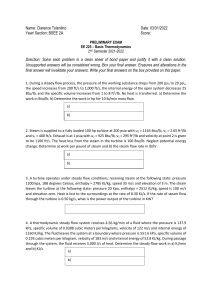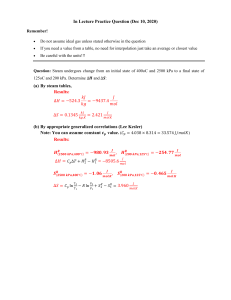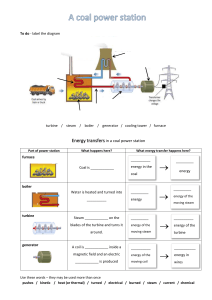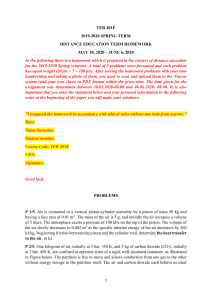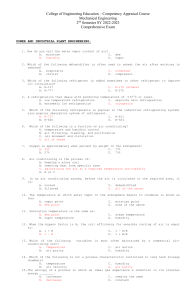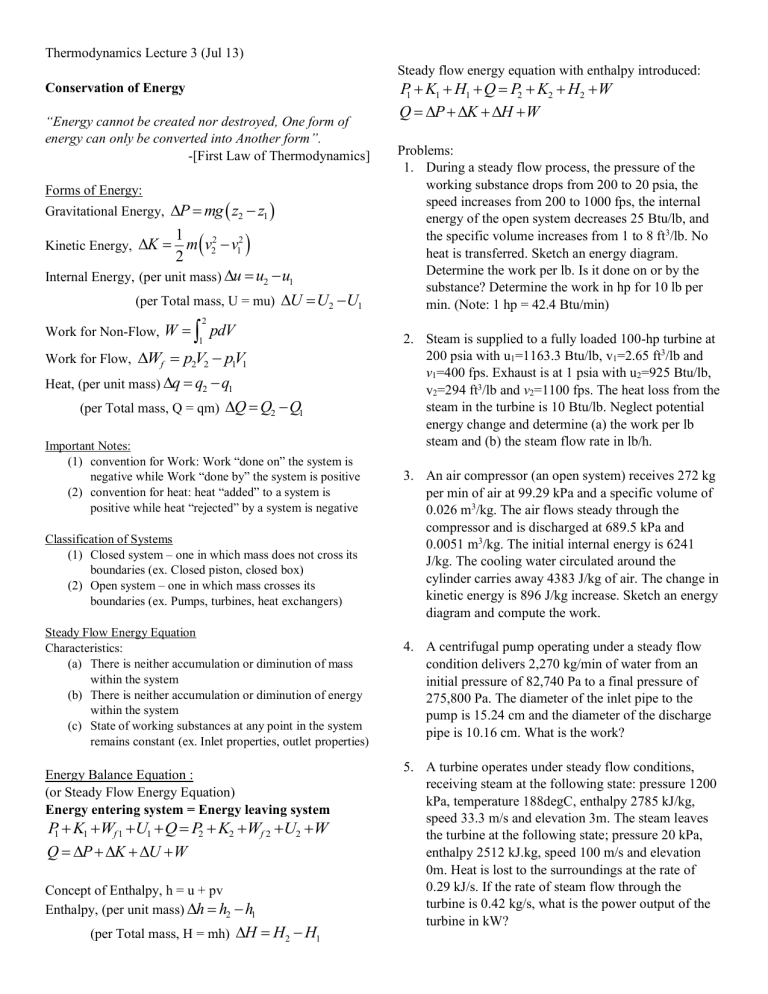
Thermodynamics Lecture 3 (Jul 13) Steady flow energy equation with enthalpy introduced: Conservation of Energy “Energy cannot be created nor destroyed, One form of energy can only be converted into Another form”. -[First Law of Thermodynamics] Forms of Energy: Gravitational Energy, P mg z2 z1 1 m v22 v12 2 Internal Energy, (per unit mass) u u2 u1 (per Total mass, U = mu) U U2 U1 Kinetic Energy, K Work for Non-Flow, W 2 1 pdV Work for Flow, Wf p2V2 pV 1 1 Heat, (per unit mass) q q2 q1 (per Total mass, Q = qm) Q Q2 Q1 Important Notes: (1) convention for Work: Work “done on” the system is negative while Work “done by” the system is positive (2) convention for heat: heat “added” to a system is positive while heat “rejected” by a system is negative Classification of Systems (1) Closed system – one in which mass does not cross its boundaries (ex. Closed piston, closed box) (2) Open system – one in which mass crosses its boundaries (ex. Pumps, turbines, heat exchangers) Steady Flow Energy Equation Characteristics: (a) There is neither accumulation or diminution of mass within the system (b) There is neither accumulation or diminution of energy within the system (c) State of working substances at any point in the system remains constant (ex. Inlet properties, outlet properties) Energy Balance Equation : (or Steady Flow Energy Equation) Energy entering system = Energy leaving system P1 K1 Wf 1 U1 Q P2 K2 Wf 2 U2 W Q P K U W Concept of Enthalpy, h = u + pv Enthalpy, (per unit mass) h h2 h1 (per Total mass, H = mh) H H2 H1 P1 K1 H1 Q P2 K2 H2 W Q P K H W Problems: 1. During a steady flow process, the pressure of the working substance drops from 200 to 20 psia, the speed increases from 200 to 1000 fps, the internal energy of the open system decreases 25 Btu/lb, and the specific volume increases from 1 to 8 ft3/lb. No heat is transferred. Sketch an energy diagram. Determine the work per lb. Is it done on or by the substance? Determine the work in hp for 10 lb per min. (Note: 1 hp = 42.4 Btu/min) 2. Steam is supplied to a fully loaded 100-hp turbine at 200 psia with u1=1163.3 Btu/lb, v1=2.65 ft3/lb and v1=400 fps. Exhaust is at 1 psia with u2=925 Btu/lb, v2=294 ft3/lb and v2=1100 fps. The heat loss from the steam in the turbine is 10 Btu/lb. Neglect potential energy change and determine (a) the work per lb steam and (b) the steam flow rate in lb/h. 3. An air compressor (an open system) receives 272 kg per min of air at 99.29 kPa and a specific volume of 0.026 m3/kg. The air flows steady through the compressor and is discharged at 689.5 kPa and 0.0051 m3/kg. The initial internal energy is 6241 J/kg. The cooling water circulated around the cylinder carries away 4383 J/kg of air. The change in kinetic energy is 896 J/kg increase. Sketch an energy diagram and compute the work. 4. A centrifugal pump operating under a steady flow condition delivers 2,270 kg/min of water from an initial pressure of 82,740 Pa to a final pressure of 275,800 Pa. The diameter of the inlet pipe to the pump is 15.24 cm and the diameter of the discharge pipe is 10.16 cm. What is the work? 5. A turbine operates under steady flow conditions, receiving steam at the following state: pressure 1200 kPa, temperature 188degC, enthalpy 2785 kJ/kg, speed 33.3 m/s and elevation 3m. The steam leaves the turbine at the following state; pressure 20 kPa, enthalpy 2512 kJ.kg, speed 100 m/s and elevation 0m. Heat is lost to the surroundings at the rate of 0.29 kJ/s. If the rate of steam flow through the turbine is 0.42 kg/s, what is the power output of the turbine in kW?
